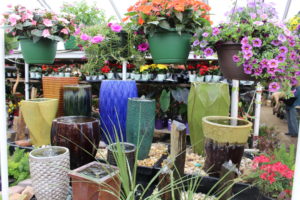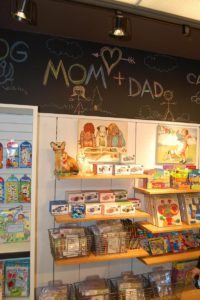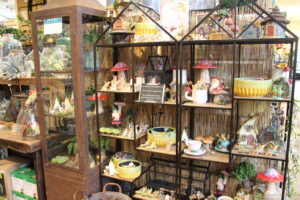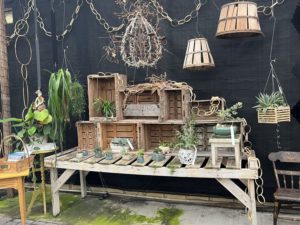Seductive Sensory Surroundings
It’s hard to believe most sellers of plants and flowers can’t find the time to make their products and the surroundings that house them as romantically desirable as the product (and sales space) demands. It’s not difficult but requires some forethought and sharing of pride and even profits. It has been historically true forever that existing, exciting and stimulating markets are made so by the care of the people who manage them. It is not simply the directive of “The Boss” who makes things happen. Those market-selling areas are part of a personal aesthetic heritage. “IT” is the sensitivity of every working stiff at all levels of participation to make their company the sine qua non of their retail existence. IT does translate into product movement, customer pleasure and profits.
The key is that IT is not seasonal or time specific. IT is what happens to your customers when they first enter and continue to circulate through your selling area. There is no question in my mind that the way we can relate the desired surroundings to aid selection of our products, the more and faster we sell. That way is composed totally by given, received and retained images. During each visit to a garden center, the pictures in our minds are sometimes preset but will always be altered to current experience. Each trip to the store provides an entirely new or repetitive series of positive or negative images. Those images are the sum total of what our senses detect and transmit to our brains. And the easy part about it is that all of us have the same reaction to most sensory stimuli.
Sensual Sales
Now that all that philosophical stuff is out of the way, let’s talk about what you can do to increase the positive sensual experiences of your customers into sales.
My background in fine art and set design for the theater was my starting point in asking, “What makes an audience or customers respond to the stimuli we preset?” Our five senses are our superb mechanisms for declaring quality. I learned about them in art school and saw their use on stage. I then applied these ideas to stores. The imagery that we project for the sensory and sensual evaluation of our clientele sets their range of acceptance.
We have five senses. While awake, most of those senses are working. They are signals to response and action. From my training of stage movement and easel painting, I had moments of nirvana when what I saw gave me the strength to say something in simple ways; we have in our selling spaces the ability to express some aesthetic ideas as laws of behavior. I remember continued lectures to a French department store company that always started with each finger being one of the five senses. Once recognized, it took 15 minutes for my interpreter to give part of the lecture in her words in French that she knew were more essential to the explanation. That’s how long it takes to make the issue clear.
Sight. Sight is the key sense. Eighty percent of the images sent to the brain start with seeing. I can only list a few of the several areas that are affected by sight. These provide some answers both for the seller and the customer.
First, let’s just list the issues that affect the perceptions given through sight. Color, depth, focus, light, shape, signs, quantity, materials and height are only words with many, many more that fit in this category. But most critical is the integration of all the above to make the visual impression you want to give. I know there are many nurseries that do a terrific job with groupings of their basic products, but I have seen great nurseries carry items that are not what I call “heritage” and present them poorly.
They know about plants and the earth, but there are items other than plants that were not part of the initial gardener’s assortments. Tools, books and wearables can be done much better in most selling areas. This should be done with the key consideration of the thought sequence that eyes transmit information to the brain. Buying decisions are made very quickly when there is visual clarity or interest. Let’s just remember that about 90 percent of all imagery starts with seeing.
Smell. Our sense of smell is the most critical. It has been estimated by various experts that we can determine between 10 and 50,000 aromas. Smell accounts for about 40 percent of our immediate perceived imagery. However, over a long period, it is the combination of smell and sight that helps record for longer periods the surroundings and images we perceive. When entering garden centers and nurseries, I can’t understand why I don’t get more smells of wood, evergreen, perfume from the flowers or coffee from the delightful little coffee area provided for setting a total ambience. Why give it away to Starbucks when our natural surroundings are what Starbucks can’t create?
Let your senses roam and think of the smells that most North Americans relate to for comfort; in North America, it’s apples and baking. In Brazil and South America, it’s coffee. In Turkey, it’s Tsimit, a baked, seeded, bagel-type bread. In most of Asia, it’s tea.
Aroma counts for the most continued memorable stimulated image. Senses that have been asleep for 50 years wake up with a distinct memorable smell. So think of all the aromatic plants and group them together so aromas will guide the direction of movement. It works better in a contained environment, but enough quantity can be effective on the exterior.
Sound. Is there a sound of customer satisfaction? Do we get the “oohs and ahs” that are uttered when they see your creations? Is there a sense of joy that is audible? You bet there is. I have lectured about this for more than 40 years and have gotten the same response from workers in stores of all types.
I ask the group I am teaching, “What is the most important sound in the store?” Management answers, “The cash register.” The staff answers music. But to customers, the most important sound is people talking to each other. When an explanation is being given about anything, a plant, service, insecticide, just watch the crowds gather. The sound level in the store created by staff speaking to customers increases their length of time in the store and, also somewhat important, the value of the transaction.
Touch. Surprisingly, the sense of touch in most selling areas is not made with fingertips. Consider that each texture invokes a new response. The issue is, “What are the elements that sponsor the ability to use touch as a gauge for sensory decisions?” To get quickly to the point, I believe our first measurement by touch comes from our feet. We feel the changes of texture from soft to hard, from manmade to natural, by simply walking on them. We even preset our touch sensory recordings by texture and light. In fact, touch is the verification of what we predetermine with senses that relate to previous experience. Consider the sense of touch as you may change the surface of a path soft to hard, grass to gravel as mental dividers of space and product.
Taste. Exclusive of food, drink and other tasty treats we can enjoy with customers, let’s think of taste as in “good and bad” taste. I kept asking my classes for a definition of those words. The best one came from a star student who also happened to be the wife of the president of Saks Fifth Avenue. “Bad taste is when you have a sequence that is disrupted by an unpleasant element. Good taste is a rhythm that is not jarred by elements being out of place.”
With that I rest my case. Repeating that mantra has provided me with an opportunity to feel the gratification of using all the theoretical education into the most wonderful life of sharing my growth with the people who use, appreciate and profit from being sensorally aware.


















 Videos
Videos





